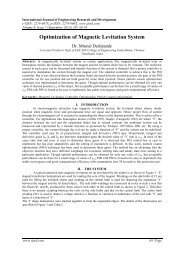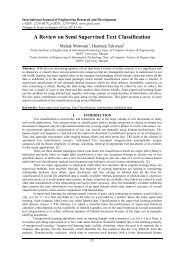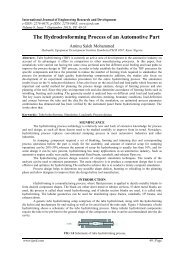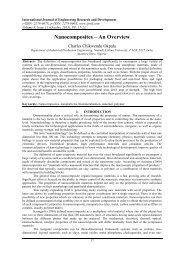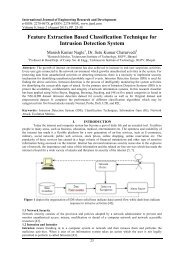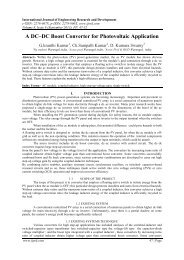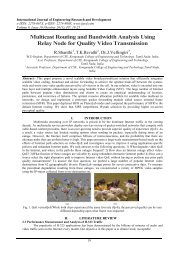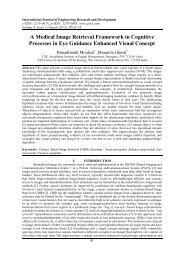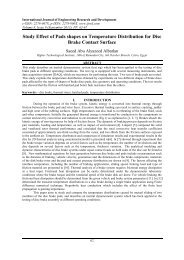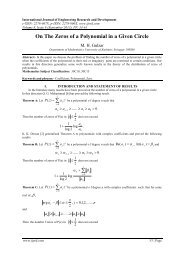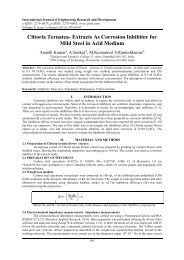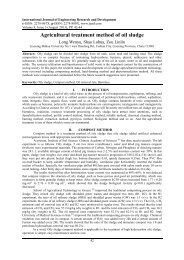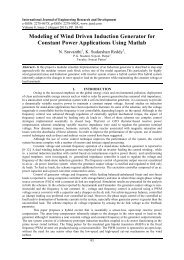Shaper Automation Using Electro-Pneumatic Devices And Plcs
Create successful ePaper yourself
Turn your PDF publications into a flip-book with our unique Google optimized e-Paper software.
International Journal of Engineering Research and Development<br />
e-ISSN: 2278-067X, p-ISSN: 2278-800X, www.ijerd.com<br />
Volume 8, Issue 2 (August 2013), PP. 49-56<br />
<strong>Shaper</strong> <strong>Automation</strong> <strong>Using</strong> <strong>Electro</strong>-<strong>Pneumatic</strong> <strong>Devices</strong> <strong>And</strong><br />
<strong>Plcs</strong><br />
Bharath 1 , Siddharam Patil 2 , R M Lathe 3<br />
1 PG Student of PDA College of Engineering Gulbarga<br />
2 HKEs Boy‟s Polytechnic BOSCH Rexroth Centre Gulbarga<br />
3 Asst Professor PDA College of Engineering Gulbarga<br />
Abstract:- Now a days as the industries are developing rapidly, man power reduces gradually in industries. In<br />
olden days almost all industries uses conventional machines for manufacturing processes. In conventional<br />
machining processes, the time consumption is very high, labour cost is high and which increases the<br />
manufacturing cost of the product. The accuracy is also not achieved as per the design requirements. To<br />
overcome all these difficulties, the industries are made automated through some devices such as electronic<br />
components, pneumatic device electrical equipments etc.<br />
For producing economically better quality products with high productivity, accuracy and quality, the<br />
conventional machine tools are being replaced gradually by the automated machine tool devices. <strong>Automation</strong> of<br />
the machines are made with help of <strong>Pneumatic</strong> device, Sensors, Mechatronics, and PLCs etc.<br />
Here the efforts are made to develop a electro pneumatic circuit for a shaping operations using a shaper<br />
machine. This makes the operations semi automatic producing shaping operations by a single point cutting tool.<br />
The three movements of the shaper are<br />
a) The reciprocating movement of the ram.<br />
b) The Crosswise movement of the tool lead across the cross rail.<br />
c) The vertical up and down movement of the table.<br />
The above movements are being automated using electropneumatic components such as pneumatic<br />
cylinders, direction control valves, flow control valves and other electrical and electronics devices.<br />
For automation of the shaper, an electropneumatic circuit is developed with the help of sensors,<br />
solenoids, electrical and electronic devices. The electro pneumatic circuit developed is simulated, executed and<br />
will be interfaced with PLCs, L10/L20 manufactured by BOSCH – REXROTH Germany. A prototype of the set<br />
up is also planned for better understanding and demonstration purpose.<br />
Keywords:- <strong>Automation</strong>, <strong>Electro</strong>pneumatic <strong>Devices</strong>, cutting tool, automated DCVs, Electrical and <strong>Electro</strong>nic<br />
<strong>Devices</strong><br />
I. INTRODUCTION<br />
The shaper is a reciprocating type of machine tool intended primarily to produce flat surfaces. The<br />
metal working shaper was developed in the year 1836 by James Nasmyth an Englishman.<br />
The <strong>Shaper</strong> machine tool holds and locates a work piece on a table and machines or cuts the work piece<br />
by feeding it against a reciprocating single point cutting tool. When the horizontal surface is being machined the<br />
table automatically feeds the work to the cutting tool on each return stroke of the ram. The surfaces cut by the<br />
shaper may be horizontal, vertical or inclined.<br />
Principal Parts of a <strong>Shaper</strong>:<br />
The following figure illustrates the different parts of a standard shaper.<br />
[Fig-1]<br />
49
<strong>Shaper</strong> <strong>Automation</strong> <strong>Using</strong> <strong>Electro</strong>-<strong>Pneumatic</strong> <strong>Devices</strong> and PLCs<br />
1. Base: The Base is the necessary bed or support required for all machine tools. The base may be rigidly<br />
bolted to the floor of the shop or on the bench according to the size of the machine.<br />
2. Column: The column is a box like casting mounted upon the base. It encloses the ram driving mechanism.<br />
Two accurately machined guide ways are provided on the top of the column on which the ram reciprocate.<br />
3. Cross rail: The cross rail is mounted on the front vertical guide ways of the column. The table may be raised<br />
or lowered to accommodate different sizes of jobs by rotating an elevated screw which cases the cross rail<br />
to slid up and down on the vertical face of the column.<br />
4. Saddle: The Saddle is mounted on the cross rail which holds the table firmly on its top.<br />
5. Table: The table which is bolted to the saddle receives cross wise and vertical movements from the saddle<br />
and cross rail.<br />
6. Ram: The ram is the reciprocating member of the shaper. Its slides on the accurately machined dovetail<br />
guide ways on the top of the column and are connected to the reciprocating mechanism contained within the<br />
column.<br />
7. Tool head: The Tool head of a shaper holds the tool rigidly, provides vertical and angular feed movement<br />
the tool and allows the tool to have an automatic relief during its return stroke.<br />
<strong>Shaper</strong> Mechanism:<br />
In a shaper, rotary movement of the drive is converted in to reciprocating movement by the mechanism<br />
contained within the column of the machine. The ram holding the tool gets the reciprocating movement. In a<br />
slandered shaper metal is removed in the forwarded cutting stroke, while the return stroke goes idle and no<br />
metal is removed during this period. The different types of the mechanisms are<br />
1. Crank and slotted link mechanism.<br />
2. Whit worth quick return mechanism.<br />
3. Hydraulic shaper mechanism.<br />
II. GENERAL CONCEPTS ON DESIGN AND DEVELOPMENT OF PNEUMATIC<br />
SYSTEMS<br />
Development of <strong>Pneumatic</strong> System<br />
The solution to a control problem is worked out according to a system with documentation playing an<br />
important role in communicating the final result. The circuit diagrams are drawn using standard symbols and<br />
labeling. Comprehensive documentation is required including most of the following<br />
Function diagram<br />
Circuit diagram<br />
Description of the operation of the system<br />
Technical data of the components.<br />
Supplementary documentation comprising<br />
Parts list of all components in the system<br />
Maintenance and fault-finding information<br />
Spare parts list<br />
A. FUNCTIONAL DIAGRAM<br />
Fig. 8.1: Functional Diagram<br />
50
<strong>Shaper</strong> <strong>Automation</strong> <strong>Using</strong> <strong>Electro</strong>-<strong>Pneumatic</strong> <strong>Devices</strong> and PLCs<br />
In majority of the pneumatic applications more than one cylinder is used. The movement of these<br />
cylinders is coordinated as per the required sequence.<br />
The activation of the limit switches of different cylinders will provide set or reset signal to the final<br />
control valves for further controlling the movement of various cylinders.<br />
The limit switches have to be arranged in the proper location with the help of motion diagram.<br />
In order to develop control circuitry for multicylinder applications, it is necessary to draw the motion diagram to<br />
understand the sequence of actuation of various signal input switches-limit switches and sensors. Multicylinder<br />
applications with three cylinders A, B and C.<br />
The status of the cylinder displacement and actuation of set and reset signals at single piloted<br />
directional control value is shown by functional diagram.<br />
Fig-Functional Diagram<br />
In majority of the pneumatic application more than one cylinder is used. The movement of these<br />
cylinder is co-ordinated as per the required sequence.<br />
In order to develop control circuitry for multi cylinder application, it is necessary to draw the motion or<br />
functional diagram, by which one will be able to understand the sequence of actuation of various signal input,<br />
by limit switches and sensors.<br />
The functional or motion diagram is that, in which graphically the sequence of operation of each<br />
cylinder is shown and it also shows the actuation of each cylinder by the cylinder switches.<br />
In the functional diagram, all the three cylinder are shown according to the sequence of operation. One<br />
cylinder has to position i.e. 0 and 1 position.<br />
„0‟ - indicates that the piston of cylinder is at backward position.<br />
„1‟ - indicates that the piston of the cylinder is at extreme forward position.<br />
Description of the functional diagram of a planer:<br />
To start with, the push button switch S1 is pressed, cylinder switch „B1‟ is already in actuation mode it<br />
sends signal to solenoid Y1 by which the piston of the cylinder „1‟ moves forward, which clamps the<br />
component.<br />
As, soon as the piston reaches to cylinder switch B2, it sends signal to solenoid Y2 by which the 2 nd<br />
cylinder piston moves forward, resulting in cutting operation. As the piston of the cylinder-2 reaches to,<br />
cylinder switch „B4‟ a loop is formed and the piston of the cylinder-2 retracts as the solenoid Y2 de-energies.<br />
As soon as the piston of the cylinder 2 reaches the backward position it activates cylinder switch B3,<br />
which sends the signal to solenoid coil „Y3‟, the piston of cylinder „3‟ moves forward making a cross feed of the<br />
tool head.<br />
When, the piston of the cylinder 3 reaches the cylinder switch „B6‟ a loop is formed by which it<br />
interrupts the voltage supply to the solenoid coil „Y4‟. Thus the piston of the cylinder „3‟ retracts.<br />
The movement of cylinder „2‟ and cylinder „3‟ in sequence continues till the change over switch is<br />
operated. When the change over switch is operated, the voltage supply to the valve solenoid Y1 is interrupted,<br />
the voltage supply to valve, solenoid „Y1‟ by which the piston of the cylinder „1‟ retracts, unclamping the<br />
component.<br />
Thus the whole circuit is reset and the machine stops.<br />
B: PNEUMATIC CIRCUIT DIAGRAM OF THREE (03) DOUBLE ACTING CYLINDERS<br />
Fig. <strong>Pneumatic</strong> Circuit diagram of 3 cylinders<br />
<strong>Pneumatic</strong> circuit diagram<br />
The 3 double-acting cylinders are controlled with 5/2 directional control valves.<br />
The valves are equipped with visual display and manual override.<br />
Valve 1 has the solenoid coils designated Yl, valve 2 has solenoid designated as Y2 and valve 3 has coil<br />
designated as Y3<br />
51
<strong>Shaper</strong> <strong>Automation</strong> <strong>Using</strong> <strong>Electro</strong>-<strong>Pneumatic</strong> <strong>Devices</strong> and PLCs<br />
When signal voltage is applied to the solenoid coils Yl, Y2 and Y3, the cylinders extend, when voltage is<br />
interrupted to the solenoid the cylinder retract.<br />
The extension speed of all 3 cylinders can be infinitely adjusted with a one-way flow control valves<br />
C: ELECTRICAL CIRCUIT DIAGRAM<br />
Fig. Electrical Circuit diagram<br />
CONTROL SECTION:<br />
The control section of the electric circuit diagram consist of a standing step sequence diagram with 6<br />
steps (6 storing step and 1 reset by C.O.S.) which are made up of the relays K1 to K6 and the assigned latching<br />
circuits.<br />
Control switch S1 is actuated, signaler B1 is actuated and signals B2, B4, B3, B6 and B5 are switched by<br />
the sequence order.<br />
In this order, one latching cicuit (step) is respectively set.<br />
Signal B5 triggers the reset step at line 3.<br />
The first latching circuit is not broken, but line No. 3 is reset by normal closed contact K6 in current path 3.<br />
This causes all further latching circuits (steps) to be reset from left to right. Now as contact point K1 is<br />
closed the continuity of current will energize coil K2.<br />
Thus the cylce continues from line no. 3 to line no. 12 the change over switch is operated in the line no. 1 to<br />
stop the maching cycle.<br />
POWER SECTION:<br />
In the power section, the contact point switches the valve solenoids corresponding to the step sequence.<br />
When using single solenoid spring return valve, there is need of continuous signals, when voltage is<br />
present at one side, the valve is operated and when there is no voltage, the valve goes to its initial position<br />
by means of spring force.<br />
Step 1: Contact K1 in current path 13 switches Y1 solenoid cylinder 1 extends and actuate the cylinder<br />
switch B2.<br />
Step 2: Contact K2 in current path 14 switches the valve solenoid Y2 via the unopened normally closed<br />
contact K3 cylinder 2 extends and actuates cylinder switch B4.<br />
Step 3: Contact K3 in current path 14 normally closed contact, now changes to normally open, and cut the<br />
current path in line 14 thus the solenoid Y2 collapse, the valve regains its original position by which the<br />
cylinder 2 piston retracts actuating the cylinder switch B3.<br />
Step 4: Contact K4 in current path 15 switches valve solenoid Y3 via the unopened normally closed contact<br />
K5, then cylinder 3 extends and actuates cylinder switch B6.<br />
Step 5: Contact K5 in current path 15 switch off Y3, as K5 is normally closed, now changes to normally<br />
open which interrupts the voltage to Y3 and cylinder 3 retracts thus actuating actual cylinder switch B5.<br />
Step 6: Contact K6 in current path 3 interrupts the current supply on line 3 to relay coil K2 where all the<br />
other lines are reset. The step sequence continues in the cylinder 2 and 3.<br />
Step 7: To stop the machining cycle completely the change over switch provided in line No. 1 when<br />
operated will reset the whole circuit. The machine stops.<br />
52
<strong>Shaper</strong> <strong>Automation</strong> <strong>Using</strong> <strong>Electro</strong>-<strong>Pneumatic</strong> <strong>Devices</strong> and PLCs<br />
TASK:<br />
Conversion of conventional shaper into a automated machine:<br />
The component to be machined is placed on the table and when the push button switch is operated, the first<br />
cylinder will clamp the component. After clamping operation, the signal is sent to the Y2 solenoid by which<br />
the second cylinder actuate, so the ram of the shaper reciprocate and does the cutting operation.<br />
After taking one cut the cylinder 2 sends the signal to the Y3 solenoid by which the cylinder 3 actuates so<br />
that cylinder the 3 extends inturn rotates a screw by a ratchet and pawl mechanism, the crosswise movement<br />
of the table is obtained (feed).<br />
Once the feed is given the cylinder 3 sends the signal to cylinder 2 so that the ram operates, taking a cut.<br />
Thus the cycle continue till the machining of the component is completed.<br />
Once the machining of the component is over, the change over switch is actuated by which the machine<br />
stops and the component is unclamped. The electrical circuit is reset.<br />
The work piece is manually taken out of the table and the table is brought back to the original position with<br />
the help of a screw.<br />
Electrically controlled 5/2 single solenoid spring returned DCV are used as actuator.<br />
Signals used are electrical cylinder switch (Magnetic field sensors or reed switches).<br />
The extension speed of all the 3 cylinder are variable, adjustable, by the flow control check valve.<br />
D: IMPLEMENTATION<br />
CONVERSION OF MANUALLY OPERATED SHAPER INTO THE AUTOMATIC UNIT:<br />
In case of conversion of the machine we need 3 double acting cylinder. One cylinder for clamping the job,<br />
the second cylinder for reciprocating the ram and the third cylinder for operating the cross slide screw<br />
(feed).<br />
Six proximity magnetic switches, two each for one cylinder, one change over switch, 3 DCV 5/2 single<br />
solenoid spring returned, 3 variable flow control valve, one pressure relief valve, compressor and the<br />
flexible pipes for necessary connections are required.<br />
12 V DC power supply, relay system, push button switch, PLC and wires for connection are also used.<br />
WORKING OF THE MACHINE:<br />
To start, the push button switch is pressed. The cylinder mounted on the table will move slowly for<br />
clamping the job. Once the clamping is over the switch B2 sends the signal to Y2 solenoid, so that the<br />
piston of the cylinder 2 moves forward moving the ram. Thus the cutting or machining stroke, takes place<br />
and the piston moves along with the ram.<br />
As the piston of cylinder 2 returns to its extreme backward position, the cylinder switch B3 will send the<br />
signal to solenoid Y3 by which the piston of cylinder 3 moves forward by which the cross feeding screw is<br />
rotated with the help of ratchet and pawl mechanism. When the piston of cylinder 3 reaches its forward<br />
position, and it returns back quickly and as the piston reaches to its extreme backward position, magnetic<br />
switch B5, sends the signal to solenoid Y2 causing the cylinder 2 to move. This process continues till the<br />
table of the machine comes in contact with the change over switch. The complete electrical circuit and is<br />
reset the machine is stopped.<br />
E: INTERFACING THE SHAPER OPERATION WITH PLC<br />
HISTORY OF PLC:<br />
Before the PLC, control, sequencing, and safety interlock logic for manufacturing automobiles and was<br />
accomplished by using hundreds or thousands of relays, cam timers, and drum sequencers and dedicated closed-<br />
53
<strong>Shaper</strong> <strong>Automation</strong> <strong>Using</strong> <strong>Electro</strong>-<strong>Pneumatic</strong> <strong>Devices</strong> and PLCs<br />
loop controllers. The process for updating such facilities for the yearly model change-over was very time<br />
consuming and expensive, as electricians needed to individually rewire each and every relay.<br />
WHAT IS A PLC:<br />
The PLC is an industrial computer. It is capable of storing instructions to implement control functions<br />
such as sequencing, timing, counting, arithmetic, data manipulation and communication. The I/O interfaces<br />
provide the connection between the PLC and the information providers (inputs like pushbuttons, sensors,...) and<br />
the controllable devices (outputs like valves, relays, lamps,...).<br />
ADVANTAGES:<br />
Less wiring.<br />
Wiring between devices and relay contacts are done in the PLC program.<br />
Easier and faster to make changes.<br />
Trouble shooting aids make programming easier and reduce downtime.<br />
Reliable components make these likely to operate for years before failure.<br />
WHERE IS THE PLC USED:<br />
The PLC controls industrial machines and processes. In different areas of the industry, PLC are being<br />
applied, e.g.: materials handling, packaging, palletizing, milling, boring, grinding, filling, sorting, weighing,<br />
mining, petrochemicals etc.<br />
LADDER DIAGRAM (LD)<br />
Ladder diagrams are used to describe the logic of electrical control system.<br />
Ladder diagrams are specialized schematics commonly used to document industrial control logic system.<br />
They are called “ladder” diagrams because they resemble a ladder, with two vertical rails (supply power) and as<br />
many “rungs” (horizontal lines) as there are control circuits to represent. If we want to draw a simple ladder<br />
diagram showing a lamp that is controlled by a hand switch, it would look like this.<br />
Fig. Simple ladder diagram<br />
54
<strong>Shaper</strong> <strong>Automation</strong> <strong>Using</strong> <strong>Electro</strong>-<strong>Pneumatic</strong> <strong>Devices</strong> and PLCs<br />
F: OPERATIONAL ANALYSIS<br />
OPERATIONAL ANALYSIS OF MANUAL AND AUTOMATED SHAPER MACHINE:<br />
Depending upon the size of the machine the cost varies. Let us consider a minimum size of the machine<br />
and do the analysis.<br />
PRODUCTION TIME:<br />
Lets us consider a square flat M.S plate with a 50x50 mm and thickness 5mm in which the top face has to<br />
be machined flat.<br />
MANUALLY OPERATED SHAPER MACHINE:<br />
The time need to produce one flat plate is 6 minutes.<br />
Total number of components produced in one hour is 10 nos.<br />
Therefore in one day 100 components are machined (total machining time taken in a day is 10 hours).<br />
AUTOMATED SHAPER MACHINE:<br />
The time need to produce one flat plate is one minute. Total number of components machined in one hour,<br />
60 components.<br />
Therefore in one day 600 components are machined (total machining time taken in a day is 10 hours).<br />
As seen from the graph the rate of production is very high in case of the automated machine as compared<br />
with the manually operated machine. Hence the productivity is high on the automatic machines.<br />
III CONCLUSION<br />
The conventional controlled machines are converted into automatic machine by which maximum operating<br />
time will be saved. Thus the output of the product will be increased. The human interventions during the<br />
machining operations are reduced. As far as this project is concerned, the machine is not fully converted<br />
into automatic machine but it is converted as a semi automatic machine, because the loading and unloading<br />
of the workpiece is done manually.<br />
But this machine can be made fully automatic by using more number of cylinders by which the work-piece<br />
is loaded automatically. By doing so the machine may run for longer time and loading and unloading can be<br />
made without stopping the machine. The number of workers are also reduced and by which the number of<br />
machines can be operated by a single operator.<br />
To conclude, this project is made keeping in mind that, any conventionally operated machines can be<br />
converted into automatic or semi automatic machines by using these devices. Late the machine is<br />
interfaced with PLCs. For this purpose one should have the full knowhow of the devices which are being<br />
55
<strong>Shaper</strong> <strong>Automation</strong> <strong>Using</strong> <strong>Electro</strong>-<strong>Pneumatic</strong> <strong>Devices</strong> and PLCs<br />
used. By doing so the existing old machines can be modified and made automatic and the procuring cost<br />
automatic machines may be reduced. Thus there is a lot of scope in this area (automation).<br />
Hence there is still wide scope in the automation area where lots of improvement can be made with the help<br />
of the latest technology.<br />
REFERENCES<br />
[1]. Fluid power controls- Anthony Espisito<br />
[2]. <strong>Pneumatic</strong> controls – Joji P<br />
[3]. <strong>Pneumatic</strong> controls manual- FESTO<br />
[4]. Hydraulic and <strong>Pneumatic</strong> Manuals- Bosch Rexroth<br />
[5]. Low cost <strong>Automation</strong> using <strong>Electro</strong> <strong>Pneumatic</strong> system –an online case study in multi station part<br />
transfer, drilling and tapping machine.<br />
[6]. Low cost <strong>Automation</strong>.<br />
[7]. Design of structured controller satisfying loop shaping using evolutionary optimization: application to<br />
a pneumatic robot Arm.<br />
[8]. The design and development of a rock cutting machine for gold mining.<br />
[9]. The research and application of Hydraulics and <strong>Pneumatic</strong>s in Huazhong University of science and<br />
technology.<br />
[10]. Design of Hydraulic circuit for CNC lathe machine converted from conventional lathe machine.<br />
[11]. <strong>Pneumatic</strong> and <strong>Automation</strong> – www.vivekengineers.net Valve automation, <strong>Pneumatic</strong> devices, electrical<br />
control actuators by Control Technology.<br />
[12]. Control <strong>Automation</strong> by Sean Davies.<br />
[13]. Flexible Manufacturing control with PLCs, CNC and software agents – Ronald Schoop.<br />
[14]. Automatic Velocity Control in cutting of machines by Carlos Machado, Jaime Fonseca and Jose<br />
Mendes.<br />
[15]. Machine Tools and <strong>Automation</strong> by H.P. Potts.<br />
[16]. CAD/CAM/CIM – New Age Publication.Computer –Aided design and manufacturing – Mikell P.<br />
Groover<br />
56




